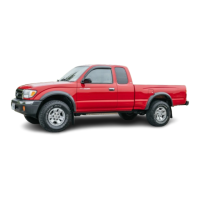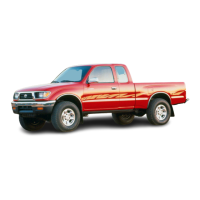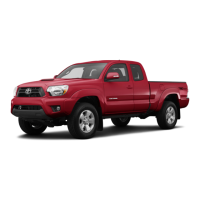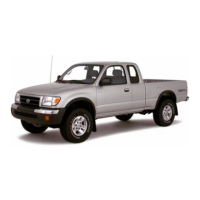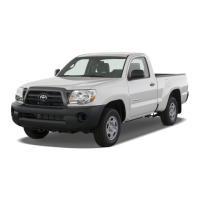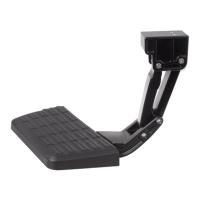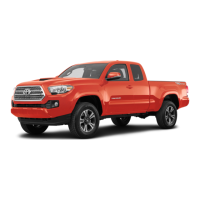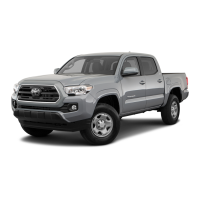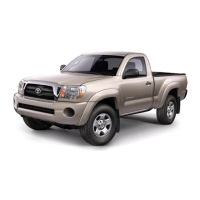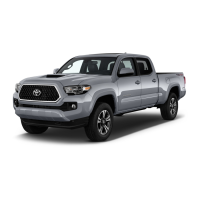Do you have a question about the Toyota Tacoma 1998 and is the answer not in the manual?
Provides an overview of the vehicle's instrument panel and its components.
Details the components of the instrument panel, including gauges and controls.
Details the instrument cluster, including gauges and indicator lights.
Explains various indicator symbols and warning lights on the instrument panel.
Details on keys, locking/unlocking doors, power windows, and other access points.
Information about the vehicle's keys and key number plate.
Details on locking and unlocking the side doors using keys or interior buttons.
Explains the operation of the power windows, including driver and passenger controls.
Instructions for operating the rear window and tailgate.
Steps for opening and closing the vehicle's hood.
Instructions on how to open and close the fuel tank cap.
Information on the detachable moon roof, including tilting, closing, and removal.
Covers seat adjustment, seat belts, steering wheel, and mirrors.
Covers seat adjustment, folding, and precautions for all occupants.
Detailed instructions on wearing, adjusting, and using seat belts, including child restraints.
Explains adjustment of tilt steering wheel and rear view mirrors, including anti-glare feature.
Information on headlights, turn signals, wipers, and interior lighting.
Explains operation of headlights, beams, signals, and hazard lights.
Details on adjusting instrument panel lights and operating interior/personal/glovebox lights.
Covers operation of windshield wipers and washers, including intermittent and mist types.
Explains gauges, meters, and service reminder indicators.
Explains the fuel gauge operation and low fuel warning.
Details the engine coolant temperature gauge and what to do if overheating occurs.
Explains tachometer, odometer, and trip meter functions for monitoring engine speed and distance.
Lists and explains various service reminder lights and buzzers and what to do when they activate.
Covers ignition switch, transmission, and parking brake operation.
Explains the ignition switch positions and steering lock operation.
Covers operation of automatic transmissions, including shift patterns, modes, and engine braking.
Details the shift pattern, recommended shifting speeds, and gear selection for manual transmissions.
Explains operation of the four-wheel drive system, including front drive control and free-wheeling hubs.
Information on the rear differential lock system, its use, and precautions.
Instructions on how to set and release the parking brake.
Covers operation of the cruise control system, including turning on, setting speed, and cancelling.
Details on the car audio and air conditioning systems.
Provides a reference for the car audio system, including basic operation, controls, and features.
Details the controls for the air conditioning system, including fan speed, temperature, air flow, and settings.
Covers miscellaneous interior equipment like clock, lighter, power outlets, and cup holders.
Instructions on setting and adjusting the digital clock.
Information on using and cleaning the cigarette lighter and ashtray, and using power outlets.
Instructions for using glovebox, cup holders, and floor mats with safety precautions.
Essential precautions for driving off-road, including sharp turns and loading.
Guidelines for breaking in a new vehicle for longevity and economy.
Information on fuel type, tank capacity, octane rating, and additives.
Explains the function of the catalytic converter and precautions for its use and maintenance.
Critical safety information regarding the hazards of engine exhaust fumes.
Explains normal engine oil consumption and the importance of checking oil levels.
Covers the brake system, including master cylinder, booster, ABS, and stopping distances.
Guidelines for safely stowing luggage and cargo to maintain vehicle balance and prevent injury.
Information on the rear step bumper's purpose and usage.
Explains the VIN and its importance for vehicle identification and registration.
Precautions regarding suspension modifications and their impact on handling.
Information on tire types (summer, all-season), their characteristics, and selection.
Checks to perform before starting the engine, such as checking surroundings and adjusting seating.
Steps to take before cranking the engine, including parking brake and transmission position.
Normal starting procedure for both cold and hot engines, and what to do if the engine stalls.
Advice for driving in adverse conditions like crosswinds, hills, and wet roads.
Essential precautions for driving off-road, including checking the vehicle and avoiding risks.
Advice for driving in winter conditions, including antifreeze, battery, and lock maintenance.
Comprehensive guide to trailer towing, including weight limits, hitches, lights, and maintenance.
Tips for improving fuel economy and extending vehicle life through proper driving habits and maintenance.
Troubleshooting steps for a vehicle that won't start, including simple checks and starting a flooded engine.
What to do if the engine stalls while driving, including reducing speed and restarting.
Steps to take if the vehicle overheats, including checking coolant and drive belts.
Detailed instructions on changing a flat tire, including tools, jacking, and wheel replacement.
Information on towing procedures, including different truck types and emergency towing.
Steps to take if the transmission selector lever is stuck in "P" position, using the shift lock override.
Advice on what to do if keys are lost, including obtaining new keys or opening the door.
Guidelines to prevent and minimize corrosion, including cleaning and protective coatings.
Instructions for washing and waxing the vehicle to maintain its appearance and prevent corrosion.
How to clean the interior, including vinyl, carpets, windows, and leather upholstery.
Explains the importance of regular maintenance for vehicle longevity, safety, and economy.
Lists general maintenance items to be checked regularly by the owner.
Clues that may indicate a need for vehicle service or repair.
Introduction to DIY maintenance, covering engine, fuses, precautions, and tools.
Identifies key components in the engine compartment for maintenance.
Shows the locations of fuse boxes in the vehicle.
Essential safety precautions to observe when performing DIY maintenance.
Lists necessary parts and tools for common DIY maintenance tasks.
Covers engine oil, coolant, brake fluid, power steering fluid, and tire maintenance.
Step-by-step guide on how to check and add engine oil, including oil selection.
Instructions for checking engine coolant level and selecting the correct coolant type.
How to check brake fluid level and the importance of using the correct fluid.
Guide to checking power steering fluid level and adding if necessary.
Importance of correct tire pressure, how to check it, and related cautions.
Explains the importance of tire rotation for even wear and extending tire life.
Guidelines for when to use snow tires or chains, and how to install them.
When and how to replace wheels, including wheel selection and precautions.
Covers battery condition, recharging, fuses, washer fluid, and light bulbs.
Safety precautions for checking the battery, including handling electrolyte and emergency measures.
Safety guidelines for recharging the vehicle battery, emphasizing ventilation and slow charging.
How to check fuses, replace blown ones, and general precautions.
Instructions on how to add washer fluid and precautions for fluid selection.
Step-by-step guide for replacing various vehicle light bulbs.
Provides detailed dimensions and weight specifications for different models and configurations.
Details engine specifications, including model type, bore, stroke, displacement, and oil capacity.
Information on fuel type and tank capacity.
Covers various service specifications, including valve clearance, spark plugs, fluids, and belts.
Lists tire sizes and recommended inflation pressures for front and rear.
Details fuse locations and amperage ratings for various vehicle circuits.
Information on how to report safety defects to NHTSA and Toyota.
Explains the DOT grading system for tires (treadwear, traction, temperature).
Provides information on truck-camper loading and matching the camper's center of gravity.
| Brand | Toyota |
|---|---|
| Model | Tacoma 1998 |
| Category | Automobile |
| Language | English |
